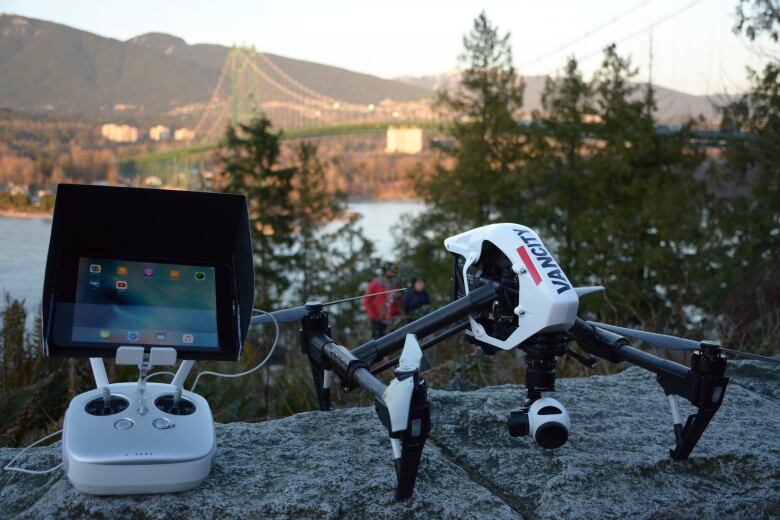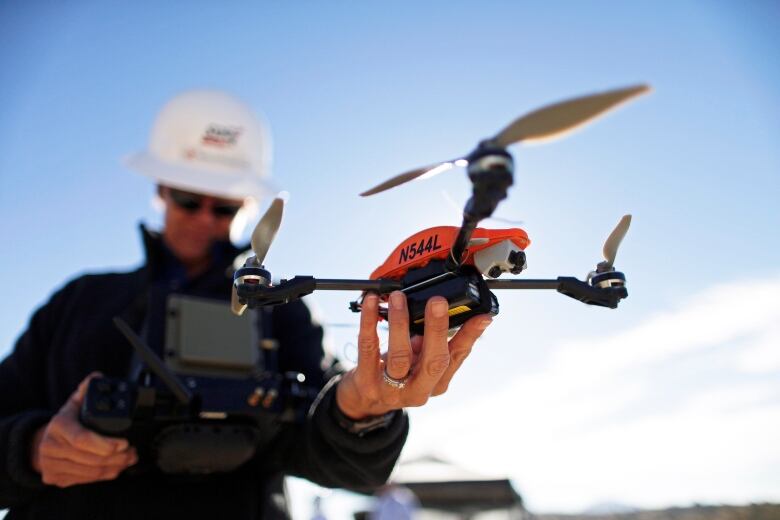Fuel cells set to power up the drone industry
Just as their commercial use begins to spread, fuel-cell technology is improving the way drones are powered

Canadian companies are placing bigbets on a better way of powering drones.
So far these stealthy unitslong used by military forces for intelligence-gathering, surveillance and striking targetshave beenpowered by internalcombustion engines orlithium polymer batteries.
But nowmanufacturers are getting ready to replace those with more efficient and longer-lasting hydrogen fuel cells in a bid to accelerate the mainstream commercial adoption of drones also knownasunmanned aerial vehicles (UAVs).

Advancementsin fuel-cell performance are being metby cost reductions and innovations on the drones themselves, saysThomas Jones, director of product development at EnergyOr, a Montreal-based company producing small- to mid-size, fuel-cell-powered drones.
New technologies converge
"We've got two new technologies that are converging at an exponential pace," says Jones. "It's exciting to be involved with optimizing them together and riding this wave of technology development."
Until now, fuel cells have been engineered for commercial use in cars and buses, and in stationary power systems like those that power somecellphone networks.Now thatthe drone revolution is disrupting a broad range of industries, manufacturers have set their sightson new, potentially lucrative markets.

A recent studyon the commercial applications of drones by consulting firm PwC, valuedthe emerging global market for business services using drones at more than $165 billion Cdn, with infrastructure, agriculture, transportationand security industries offering the most potential.
One company looking to take advantage of these opportunities is Protonex, a subsidiary of Burnaby-based fuel-cell developer, Ballard Power Systems. Protonex recently delivered its proton exchange membrane (PEM) fuel cells to Insitu, a subsidiary of U.S. aerospace giant Boeingthat produces military- and industrial-grade, long-endurance, fixed-wingdronesthe kindthat look like little airplanes.

PEM fuel cells produce electric power on board the droneby reacting hydrogenin either liquid or gas formwith oxygen. With water as its only byproduct, fuel cells are a clean power solution.
Insitu is now testing Protonex's systemin thehope ofrolling out a commercial, liquefied hydrogen fuel-cell version of its ScanEagle drone in 2017. This isone of the most widely used,high-endUAVs around, having logged miles on military missionsfrom Iraq to the Somali coast.
Insiturepresentativessay theybelievethat, for some users, thenew fuel-cell-powered ScanEagle will bringadvantages over its current internal combustion engine.
Longer flight times
Both power sources offer long-endurance capabilities a necessity for the eight-to 12-hour flight missions required by Insitu's clients. But fuel cells offer lower noise levels and heat signatures, too, which are particularly compelling features for militaries using drones on clandestine missions.
Fuel cells with fewer moving parts break down less oftenthan internal combustion engines. They also vibrate less, saysAndrew Hayes, director of advanced development at Insitu. That makes forgreater stability, important to commercial clients keen to use the drone's sensors and cameras to collect clearer data and visuals, he says.
"Ultimately, all the customer wants is that data," saysHayes. Some of the applications the company is eyeing include inspectingoil pipelines and railway tracks, fighting forest fires, and monitoring minesites.

For smaller, shorter-endurance, multi-rotordrones those that look like small helicoptersfuel cells offer even greater competitive edges over the standard power source, rechargeable lithium polymer batteries. Currently, batteries offer flight times of between 15 and 30 minutes on a single battery charge. But hydrogen fuel cells can power drones for up to threehours and are quickly refuelled after landing.
Hydrogen fuel cells have higher "energy density,"meaning manufacturers canget a lot of energy on board for much less weight, says Jones of EnergyOr.
"That translates into longer endurance what it's really all about for us," he says.
EnergyOr's hydrogen gas fuel cells are now being tested in joint projects with France's Air Force and Spain's National Guard.
Regulators scrambleto keep up
But the rise of drones raises societal concerns, and regulators are only starting to get the legal frameworks in place for their safe andbeneficial use.
This summer, U.S. transportation and aviation authorities announced national guidelines for non-recreational unmanned aircraft under 25 kg. Transport Canada requires commercial drone operators to get a special flight certificate advising how the UAV can be used. As drones encroach populated areas and flight paths,the evolution of these rules will be critical.

Drones are also getting more popular for recreational use in Canada, which does not require a flight certificate for drones under 35 kg. This paves the way for noviceswho may not understand the limitations of their drones' battery life, for example.
And privacy issues still need to be addressed, as regulations don't cover what kinds of informationdrones can collect and how that information isused. Perhaps most concerning to the average person: drones can easily capture personalphotos and videos.
"Transport Canada does a good job ... when it comes to safety issues, but I think that there are other social issues that also need to be addressed," saysKristenThomasen, a legal experton dronesandincoming professor of law androbotics at the University of Windsor.
Thomasen saysshe believes that apressing next stepis for legal experts, engineersand the public to discuss the privacy implications and the nuisance of buzzing drones overhead.
Despite these questions, Hayes, of Insitu, foresees fuel cell drones taking off in both the military and civilian markets."I think the fuel cell technology is going to be one of the keys to unlocking that market in a way that we can't do today."













_(720p).jpg)


 OFFICIAL HD MUSIC VIDEO.jpg)
.jpg)



























































































